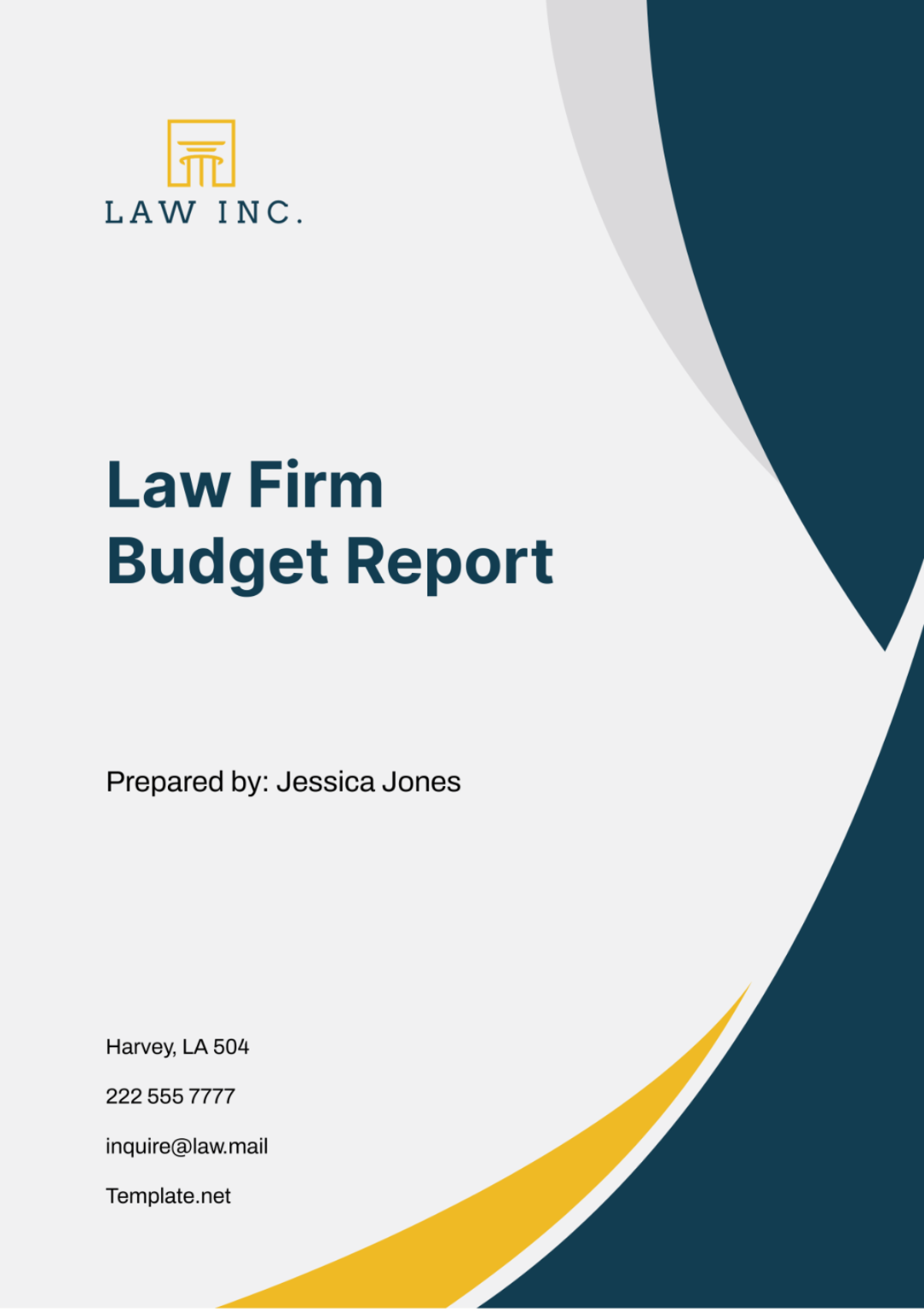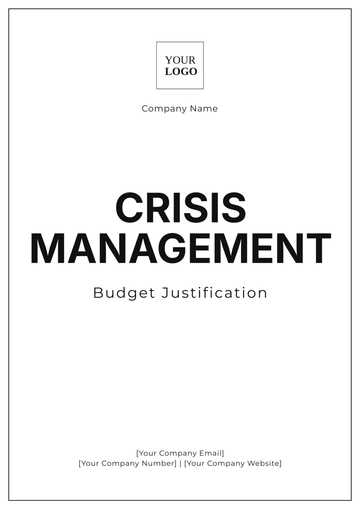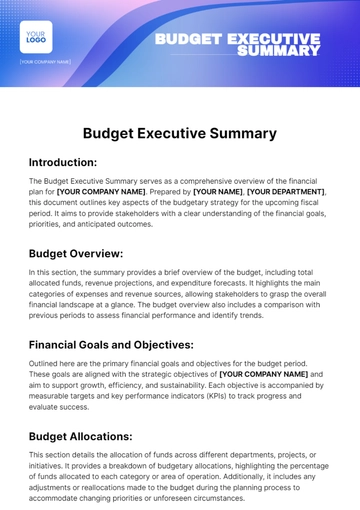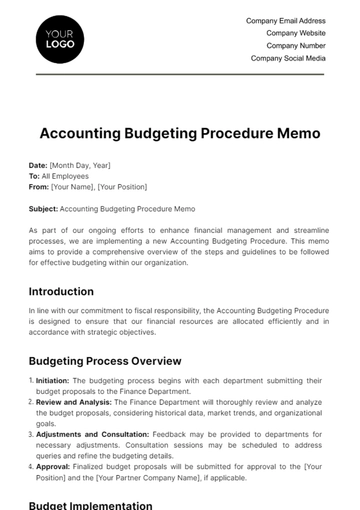Free Law Firm Budget Report

I. Executive Summary
The budget report presents a comprehensive overview of [Your Company Name]'s financial projections for the fiscal year [Year]. Through meticulous analysis of both revenue forecasts and expense projections, this report aims to provide a clear understanding of the firm's financial trajectory, facilitating informed decision-making and strategic planning.
In the upcoming fiscal year, [Your Company Name] anticipates total revenue of $730,000, derived from various sources including legal services, retainer agreements, consultation fees, and other avenues. Concurrently, projected expenses are estimated at $600,000, encompassing salaries, office rent, utilities, legal research tools, marketing expenses, and other operational costs. This Executive Summary provides a condensed view of the firm's financial outlook, highlighting key figures and setting the stage for a detailed analysis of revenue streams, expenditure patterns, and strategic recommendations.
II. Revenue Projection
The revenue projection section forecasts the firm's income sources for the upcoming fiscal year. This includes fees from legal services, retainer agreements, and any other sources of revenue. The table below outlines the revenue projections:
Revenue Source | Projected Amount ($) |
|---|---|
Legal Services | $500,000 |
Retainer Agreements | $150,000 |
Consultation Fees | $50,000 |
Other Sources | $30,000 |
Total Revenue | $730,000 |
Legal Services: This category encompasses fees generated from providing legal services to clients. These services may include litigation, corporate law, real estate transactions, intellectual property matters, and other legal specialties. The projected revenue from legal services for the fiscal year is estimated at $500,000.
Retainer Agreements: Retainer agreements involve clients paying a predetermined fee to secure ongoing legal services from the firm. These agreements often provide a steady source of income and client engagement. The projected revenue from retainer agreements for the fiscal year is estimated at $150,000.
Consultation Fees: Consultation fees are charges for providing legal advice or initial assessments to potential clients. These fees may be billed on an hourly basis or as a flat rate for the consultation session. The projected revenue from consultation fees for the fiscal year is estimated at $50,000.
Other Sources: This category encompasses any additional sources of revenue not covered by the above categories. It may include revenue from ancillary services, referral fees, or income from investments. The projected revenue from other sources for the fiscal year is estimated at $30,000.
Total Revenue: The total projected revenue for the fiscal year, combining all sources mentioned above, is $730,000. This figure serves as a key indicator of the firm's expected income and forms the basis for financial planning and resource allocation.
III. Expense Projection
The expense projection section details the anticipated costs associated with running the law firm. This encompasses salaries, office rent, utilities, legal research tools, marketing expenses, and other operational expenditures. The table below presents the expense projections:
Expense Category | Projected Amount ($) |
|---|---|
Salaries | $350,000 |
Office Rent | $120,000 |
Utilities | $15,000 |
Legal Research Tools | $25,000 |
Marketing Expenses | $50,000 |
Other Operational Costs | $40,000 |
Total Expenses | $600,000 |
Salaries: Salaries represent the compensation paid to attorneys, paralegals, administrative staff, and other personnel employed by the firm. The projected expense for salaries for the fiscal year is estimated at $350,000.
Office Rent: Office rent includes the cost of leasing office space for the firm's operations. This expense is typically a significant portion of the firm's overhead costs. The projected expense for office rent for the fiscal year is estimated at $120,000.
Utilities: Utilities encompass expenses related to electricity, water, heating, cooling, and other essential services required to maintain the office environment. The projected expense for utilities for the fiscal year is estimated at $15,000.
Legal Research Tools: Legal research tools include subscriptions to databases, online legal libraries, and software platforms essential for conducting legal research and staying updated on case law and regulations. The projected expense for legal research tools for the fiscal year is estimated at $25,000.
Marketing Expenses: Marketing expenses cover promotional activities aimed at attracting new clients and enhancing the firm's visibility in the marketplace. This may include website maintenance, advertising campaigns, networking events, and branding efforts. The projected expense for marketing for the fiscal year is estimated at $50,000.
Other Operational Costs: Other operational costs encompass various day-to-day expenses not categorized elsewhere, such as office supplies, professional dues and subscriptions, travel expenses, and maintenance costs. The projected expense for other operational costs for the fiscal year is estimated at $40,000.
Total Expenses: The total projected expenses for the fiscal year, combining all categories mentioned above, amount to $600,000. This figure represents the anticipated expenditure required to sustain the firm's operations and serves as a critical component of financial planning and budget management.
IV. Budget Analysis
The budget analysis section provides a comprehensive evaluation of [Your Company Name]'s financial projections for the fiscal year [Year]. By comparing the projected revenue and expenses, analyzing key performance indicators, and considering historical data and industry benchmarks, this analysis aims to assess the firm's financial health and identify areas of strength and improvement.
Revenue vs. Expenses: The comparison of projected revenue to expenses reveals a positive outlook for [Your Company Name]. With projected revenue of $730,000 and anticipated expenses of $600,000, the firm is forecasted to maintain a healthy profit margin. This indicates that [Your Company Name] is operating efficiently and generating sufficient income to cover its operational costs while leaving room for profitability and growth.
Profitability Ratios: Calculating profitability ratios, such as the gross profit margin and net profit margin, provides further insights into the firm's financial performance. The gross profit margin, which measures the percentage of revenue retained after deducting the cost of goods sold (in this case, the cost of legal services), reflects the efficiency of [Your Company Name]'s operations in generating profit. Similarly, the net profit margin, which considers all expenses, including operating expenses and taxes, provides a broader perspective on the firm's overall profitability.
Expense-to-Revenue Ratios: Analyzing expense-to-revenue ratios helps assess the firm's cost structure and efficiency in managing expenses relative to revenue. By comparing expenses as a percentage of revenue over time and against industry benchmarks, [Your Company Name] can identify areas of potential cost savings and optimize resource allocation.
Historical Performance and Industry Benchmarks: Examining historical financial data and industry benchmarks allows [Your Company Name] to contextualize its current budget projections and performance. By benchmarking against peer firms or industry standards, [Your Company Name] can identify areas of relative strength and areas needing improvement, informing strategic decision-making and resource allocation.
Risk Assessment: Assessing potential risks and uncertainties that may impact the firm's financial performance is crucial for proactive risk management. Factors such as economic conditions, regulatory changes, client fluctuations, and competitive pressures should be considered in the budget analysis to mitigate risks and ensure resilience against unforeseen challenges.
V. Recommendations
Based on the budget analysis conducted for [Your Company Name], the following recommendations are proposed to optimize financial performance and enhance the firm's overall efficiency and competitiveness:
Implement Cost-Containment Measures: Identify opportunities to reduce unnecessary expenses without compromising the quality of service. This could involve renegotiating contracts with vendors, optimizing office space utilization, and streamlining operational processes to minimize waste and overhead costs.
Diversify Revenue Streams: Explore additional avenues for generating revenue beyond traditional legal services. This could include offering specialized consulting services, developing proprietary software tools or informational products, or expanding into new practice areas or geographic markets.
Enhance Billing and Collection Practices: Improve billing processes to ensure timely and accurate invoicing, and implement proactive strategies for collections to reduce accounts receivable and improve cash flow. Consider offering alternative fee arrangements or payment plans to accommodate clients' needs while maintaining profitability.
Invest in Technology and Automation: Embrace technology solutions to streamline workflows, enhance productivity, and reduce administrative burdens. This could involve implementing practice management software, document automation tools, and client relationship management (CRM) systems to improve efficiency and client service delivery.
Optimize Marketing Efforts: Invest in targeted marketing initiatives to attract new clients and retain existing ones. Develop a comprehensive marketing strategy that leverages digital channels, networking events, thought leadership content, and client referrals to increase visibility and market presence.
Focus on Client Retention and Satisfaction: Prioritize client satisfaction and retention by delivering exceptional service, maintaining open lines of communication, and proactively addressing client concerns and feedback. Develop client loyalty programs and referral incentives to incentivize repeat business and positive word-of-mouth referrals.
Invest in Professional Development: Allocate resources towards ongoing training and professional development programs for staff to enhance skills, stay abreast of industry trends, and maintain competency in specialized practice areas. This could include sponsoring continuing education courses, workshops, and certifications relevant to employees' roles and career goals.
Monitor Key Performance Indicators (KPIs): Establish and regularly monitor key performance indicators (KPIs) related to financial metrics, client satisfaction, employee productivity, and operational efficiency. Use KPIs to track progress towards strategic objectives, identify areas for improvement, and make data-driven decisions.
Evaluate Pricing Strategies: Review and adjust pricing structures for legal services to ensure they align with market demand, client expectations, and the firm's profitability objectives. Consider implementing value-based pricing models or alternative fee arrangements that offer transparency and flexibility while maintaining profitability.
Sustain a Focus on Sustainability: Integrate sustainable practices into the firm's operations, such as reducing paper consumption, minimizing energy usage, and adopting environmentally friendly office policies. Promote a culture of corporate social responsibility (CSR) and ethical business practices to attract socially conscious clients and employees.
VI. Conclusion
In conclusion, the budget report provides valuable insights into the financial outlook of [Your Company Name] for the fiscal year [Year]. By carefully monitoring revenue streams and controlling expenses, the firm can achieve its financial objectives and sustain long-term growth. Implementation of the recommendations outlined in this report will further strengthen the firm's position in the legal marketplace.
- 100% Customizable, free editor
- Access 1 Million+ Templates, photo’s & graphics
- Download or share as a template
- Click and replace photos, graphics, text, backgrounds
- Resize, crop, AI write & more
- Access advanced editor
Manage your law firm's finances effectively with Template.net's Law Firm Budget Report Template. Editable in our AI Editor Tool, this customizable template provides a structured format for tracking budget allocations, expenses, and variances within your firm. Enhance financial visibility, make informed decisions, and achieve fiscal responsibility effortlessly with this well-crafted template from Template.net!
You may also like
- Budget Sheet
- Personal Budget
- Non Profit Budget
- Monthly Budget
- Project Budget
- HR Budget
- Company Budget
- Home Budget
- Weekly Budget
- College Budget
- Business Budget
- Construction Budget
- Small Business Budget
- Hotel Budget
- Annual Budget
- Home Renovation Budget
- Household Budget
- Student Budget
- Grocery Budget
- Marketing Budget
- Corporate Budget
- Startup Budget
- Manufacturing Budget
- Church Budget
- University Budget
- Annual Budget Plan
- Event Budget
- Operating Budget
- Travel Budget
- Food Budget
- IT and Software Budget
- School Budget
- Real Estate Budget
- Sales Budget
- Conference Budget
- Budget Finance
- Freelancer Budget
- Budget Advertising







